One of the most impressive forms of the Devi at Khajuraho is on the outer wall of the Lakshmana Temple.
 |
| Yogeshwari, Or Ambika... or Durga. |
The goddess stands gracefully, with various objects in her ten hands. The sword, shield, rosary, dagger, bell, and trishul are clearly visible, a couple of hands are broken, and one is in a benevolent pose, or
varada mudra. The lions at her feet tell us she is Durga, though she is also called Ambika or Yogeshwari, as per the iconography.
Her presence in a Vishnu temple is not surprising. After all, Durga is created by the combined powers of all the Gods, including Vishnu. Besides, she is also considered to be the sister of Vishnu. What is surprising, however, is her presence in a series of images, along with Ganesha and seven of the nine planets. They all stand in prominent niches on the outer wall of the Lakshmana Temple, enhancing the presence of the cosmos in the temple. While Ganesha stands as the first in this series of images, she is at the end, as if completing them, or making them whole.
I have begun this post on the Devi with this image, because she is the form of the goddess we are most familiar with. Yet, she is placed in an unusual group of deities. This, to me, is so typical of everything at Khajuraho - where we see everything that is familiar, in a different way - especially when it comes to the Devi.
Inside the main hall of the same temple (Lakshmana Temple), and around the sanctum, we see her again in both, familiar, as well as unfamiliar forms......
(Please excuse the quality of the images. Low light and constant crowds made photography difficult inside the shrines)
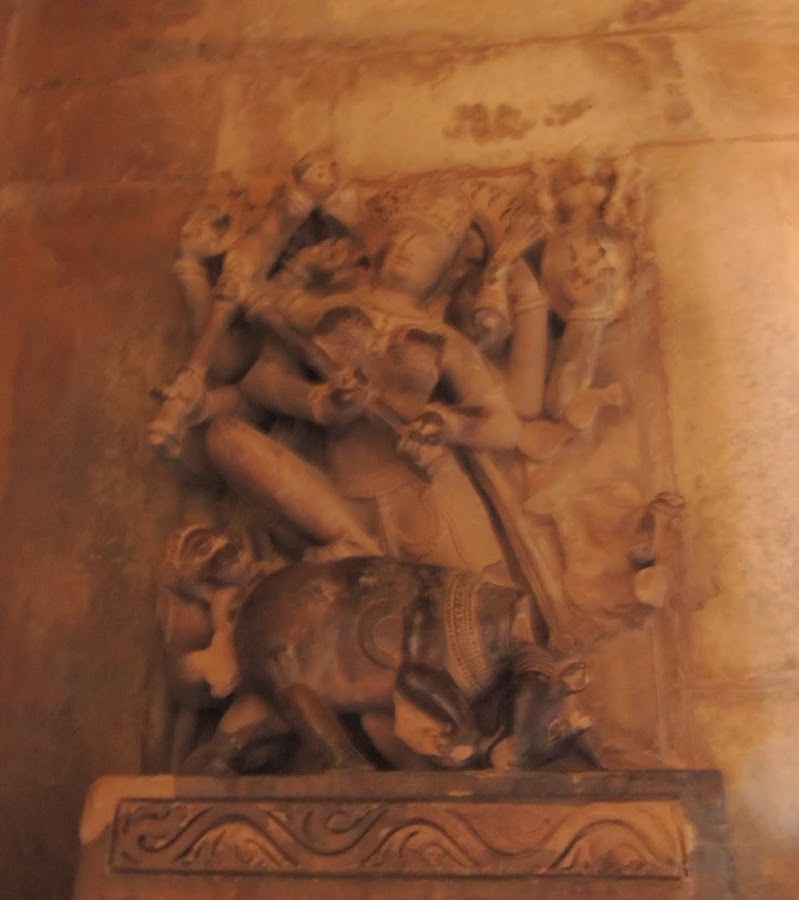 |
| Mahishasuramardini, the one form we can identify so easily, as she is shown at the moment of killing the buffalo demon, Mahishasura. |
 |
| Parvati - She stands straight, with her lion on her right and deer on her left. Her posture, as well as position suggests she is Parvati in Panchagni Tapas, though the Agni kunds are not shown here. |
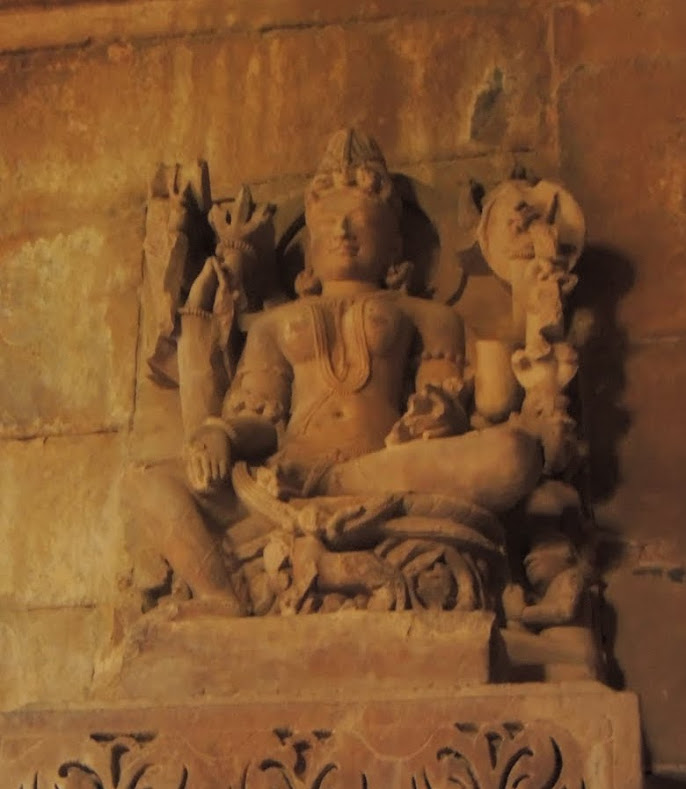 |
| Chandika - An unusual depiction of the goddess, where she is seated, and shown in a beautiful form. However, she can be identified as Chandika because of the skulls around her hair, which is tied in a jata. the skull cup she holds in one of her hands, and a long garland of skulls which hangs around her. |
 |
| Gajalakshmi, easily identifiable by the two elephants which pour water over her |
 |
On the left: Ambika, or Mother goddess, with a child in her hands.
On the right: Kshemankari, seated , with two lions below her.
Ambika and Kshemankari depicted together in the south west corner of the shrine are believed to bestow health and well being. |
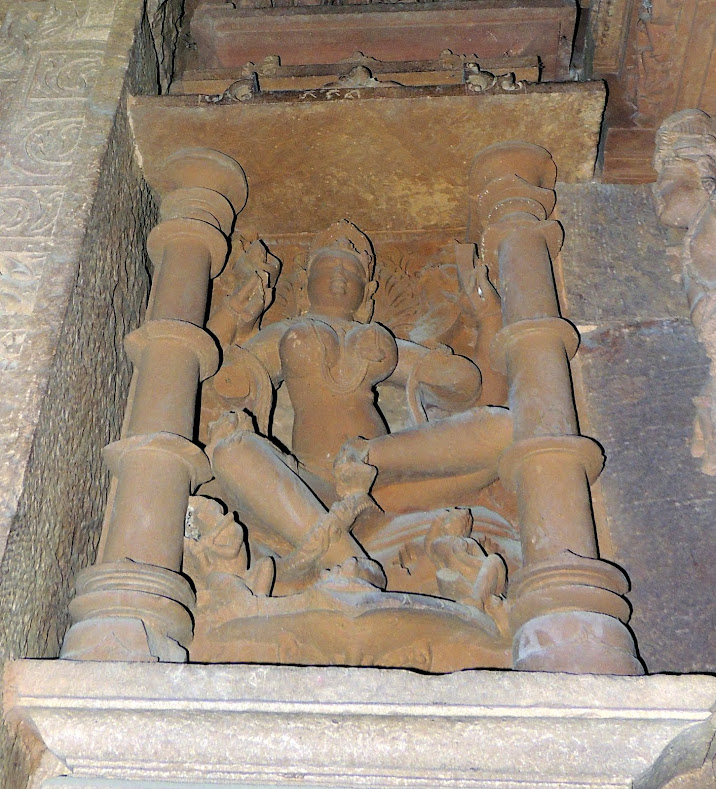 |
| Saraswati, who once had a veena in her hand, but which is now broken. |
It is thus interesting to see that the Devi is visible in all her important forms - as Parvati, Lakshmi, Saraswati, and the mother in general, within just this one temple.
Then, there are the traditional forms of the goddess, such as this one, of Parvati, on the outer walls of the other temples as well.
 |
| Seated Parvati, Kandariya Mahadev Temple |
Another form of the goddess as mother, is visible on one of the upper niches of the spire...
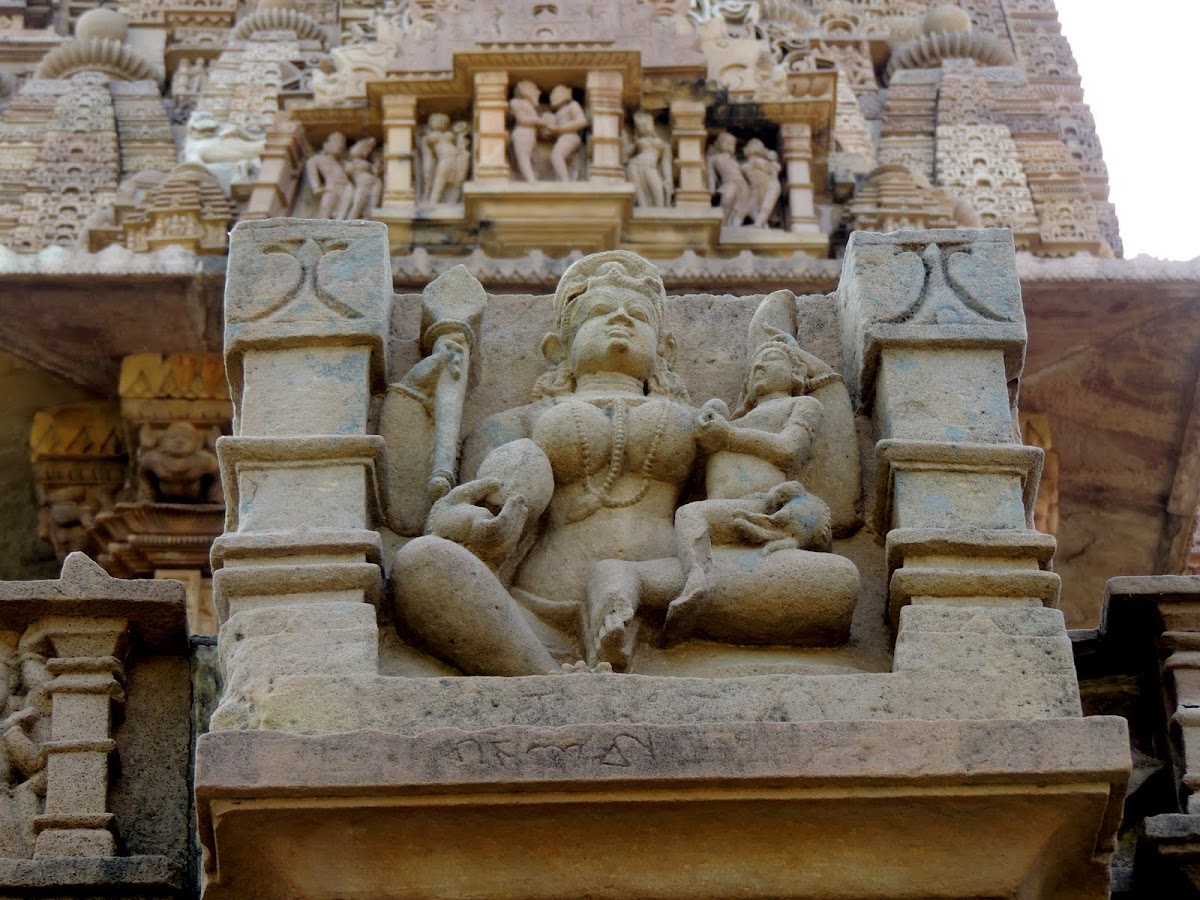 |
| Mother Goddess, or Matrika, seated with a child on her lap. She holds a fruit and a spear in two of her hands, which makes me wonder if this is Parvati as the mother of Kartikeya? |
The concept of the Devi as mother, or Matrika is especially visible in the Kandariya Mahadev and the Vishwanatha Temples, where the Saptamatrikas are so beautifully shown circumambulating the shrine. Though they are broken, their beauty and grace is still visible. They are not shown with children, but in fact, are in a dancing posture, as if they are dancing around Shiva himself! Further, they are depicted in reverse order, which suggests that they are just completing one round around the Lord!
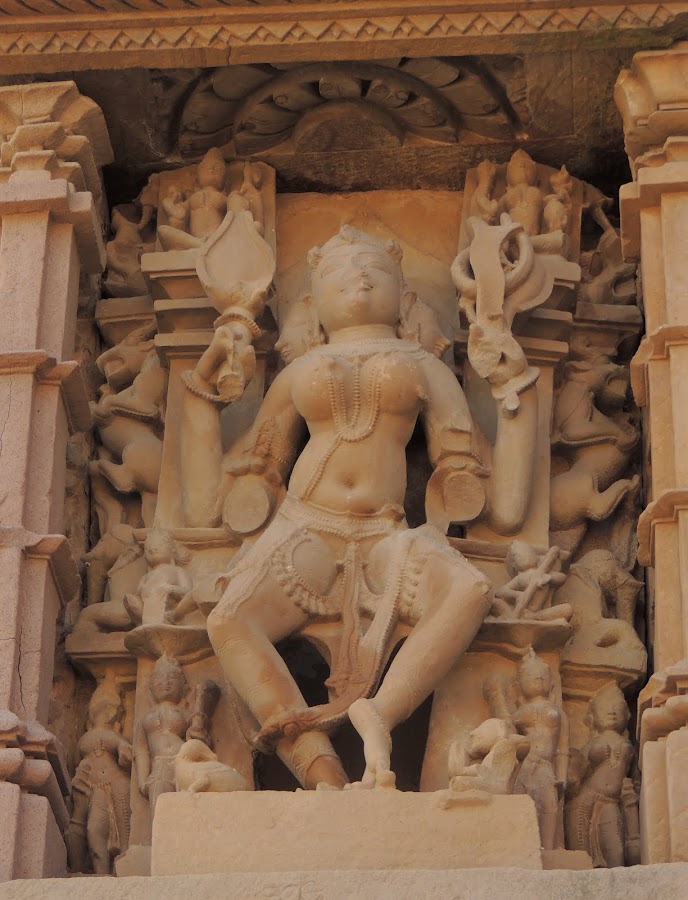 |
| Brahmani : Notice the three heads, and the swan, her vahana, near her feet. |
 |
| Maheshwari : We can only see the snake in one of her hands, but Nandi by her feet, craning up his neck to look at her, confirms her identity |
 |
| Kaumari: She is my favourite among the seven! Her mount, the peacock is clearly visible, as are three of her six heads! |
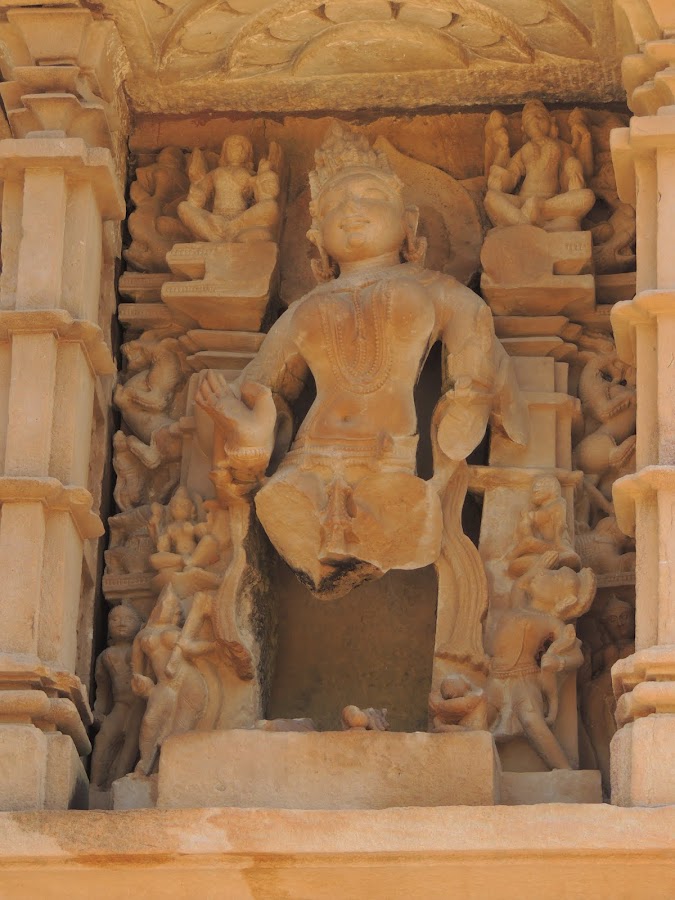 |
| Vaishnavi: She is identified only by the Garuda sitting at her feet |
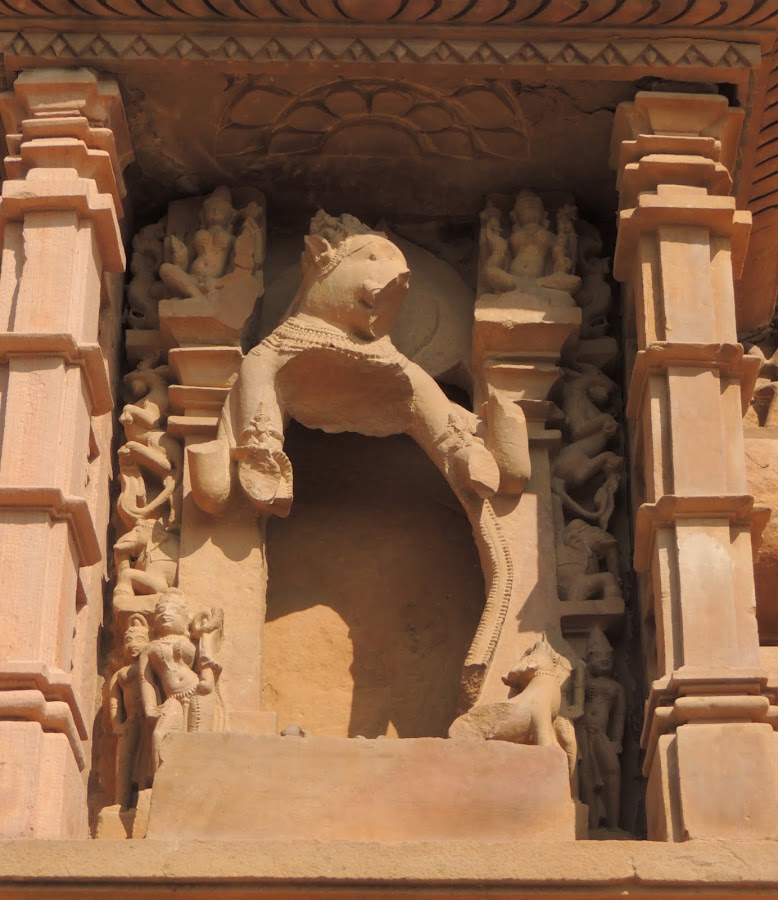 |
| Varahi: So much of her is broken, but her face shows she is Varahi |
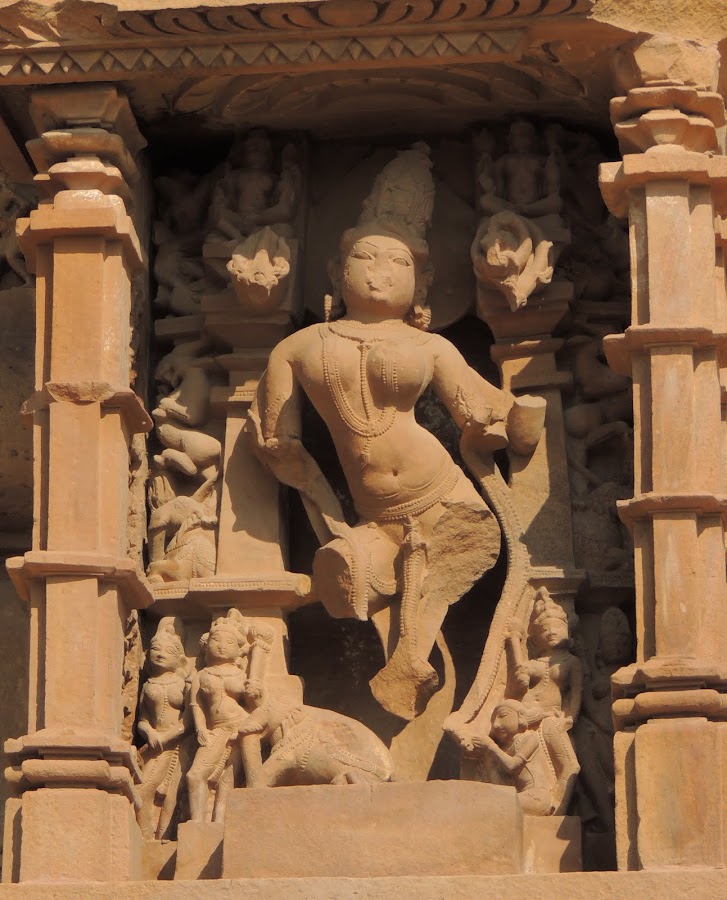 |
| Indrani: Part of her Vajra is seen, as is her mount, the elephant. |
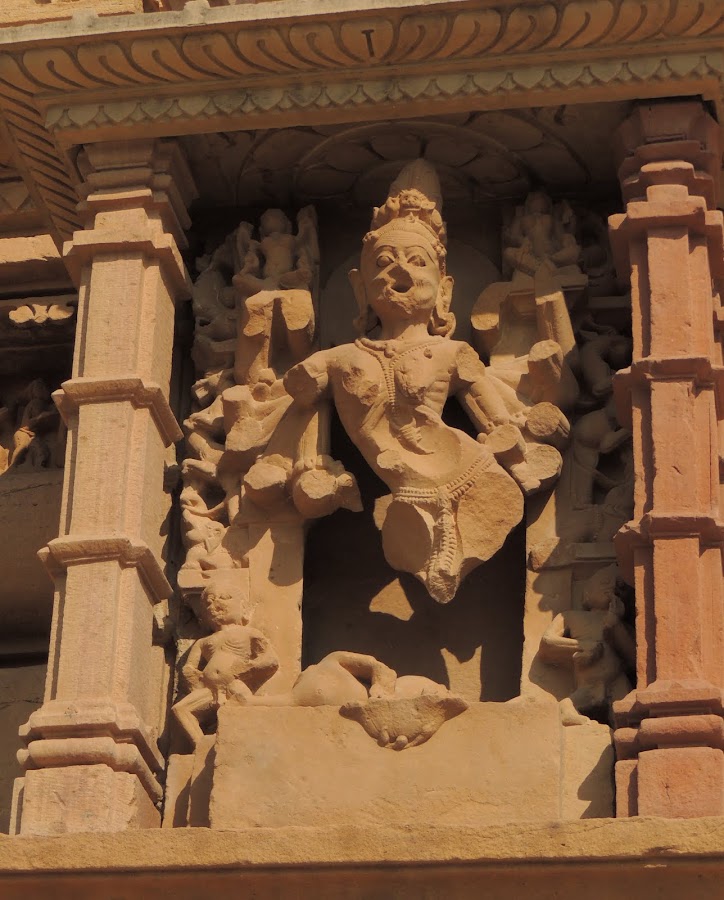 |
| Chamunda : She is broken, and disfigured, besides, she is meant to typify Bibhatsa, or gruesomeness, yet, she is beautiful! Her skeletal body is so intricately carved, and the scorpion on her stomach adds to the gruesome touch. |
Another gorgeous image of Chamunda is seen at the Duladeo Temple, one of the last temples to be built at Khajuraho...
 |
| Chamunda, Duladeo Temple: This image is broken too, but a lot more detail is visible. The skeleton figures below her, the garland of skulls, and even her expression add to the Bibhatsa rasa that she invokes in us. Notice that instead of the scorpion, there is now a lizard on her stomach! |
We see the Matrikas at other temples too. But, with time, the depiction of the goddess changes, and she takes a more standard form. At the Vamana temple, two niches have these goddesses...
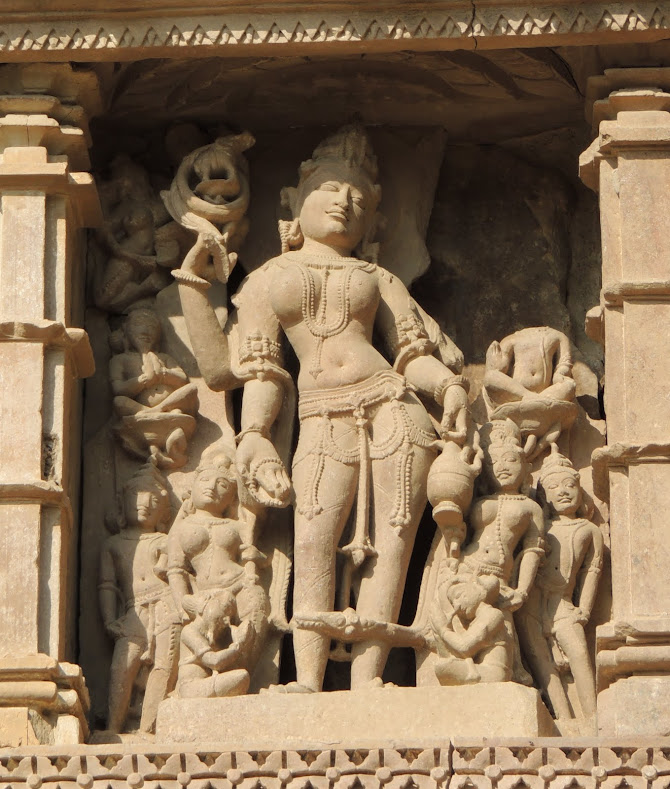 |
| This figure from the Vamana temple is probably Indrani, because the curved lotus stalk she has in her hand is carved with an elephant. |
 |
| This figure, also from the Vamana temple, is also probably a Matrika, but identification is difficult since we cannot see her Vahana or other identifiable attributes. |
At the Chaturbhuja Temple, we see her in an unique form - as Narasimhi...
 |
| Narasimhi - the lion faced goddess. She is depicting as smiling and benevolent, instead of fierce, and devotees are shown praying to her. |
With so many forms of the Goddess in the temples of Khajuraho, we would expect temples to her as well. However, there are only two temples where she stands in the sanctum - the Jagadambi temple, and the Parvati temple.
 |
| Goddess in sanctum of Jagadambi Temple |
However, it is believed that both these temples were originally dedicated to Vishnu, which effectively means that none of the grand temples which stand here are dedicated to the goddess.
Now, this is quite surprising, since the oldest temple at Khajuraho, dating back to 900 AD, is dedicated to the Chausath Yoginis - 64 forms of the goddess. The rectangular temple complex, open to the skies, with individual shrines to the Yoginis, is unique, since all other shrines to the goddesses are circular.
 |
| Shrines to the 64 Yoginis at the Chausath Yogini Temple |
The Chausath Yoginis would all have been unique forms of the Devi, each with their own attributes and vehicles. Sadly, the shrines stand empty, bereft of their deities. Only three images remain, that too in the museum.
This unique temple, which is among the oldest in the region, suggests the presence of a strong cult of Yogini worshippers at Khajuraho. The cult may have been Tantric in nature, and while this has often been cited as the reason for the erotic sculptures seen on the walls of the temples, it is interesting, as well as rather sad, to note that the Devi does not have a prominent presence by herself in any of the later temples. She is seen more often as a consort, than by herself, except when depicted as a Matrika, barring a few instances of course.
Thus, in the temples where the female form is given great importance, the goddess seems to be venerated most as a mother. A mother is the epitome of benevolence, to her children. But when angered, can wreak havoc on those that threaten her, or her children. Isn't it interesting that it is this aspect of her which is so beautifully and repeatedly engraved on the walls of the temples?
Another angle to this is the changing view of the feminine form - from being seen as the goddess in many forms in the Chausath Yogini temple, to being venerated as a Matrika, or mother, to being relegated to the position of a consort. Do we see the transition in the position of women through the depiction of the Devi at Khajuraho? The temples do, after all represent art over a period of 300 years, that too, a period when major changes were afoot, in all aspects of life - political, social, cultural and religious!
This is especially relevant in the context of the Chandelas who built these temples. While the Chandelas built these temples to the popular Brahminical and Jain deities of the period, they themselves worshipped Maniya Devi, a tribal goddess, whose temples aren't the magnificent stone monuments we see at Khajuraho, but simple structures. She is the simple folk goddess, one closely associated with nature, fertility and protection. Does this aspect of the goddess come through in the stone sculptures of the Devi at Khajuraho, where she epitomises protection and fertility in the form of the mother?
My thoughts and questions will never end, but this post has to, if I have to get along with my series, showing you more deities at Khajuraho! Look out for my next post!
Related Posts:
Nice pictures with useful description...
ReplyDeleteThank you sharing with us all the pictures ... I have not been here so maybe some day
ReplyDeleteBikram's
I have lost my heart to Narasimhi. She is absolutely gorgeous. You don't have other pictures of her, do you?
ReplyDeleteEnjoying your Khajuraho series very much, Anu. May I say that this is one of your best set of posts?